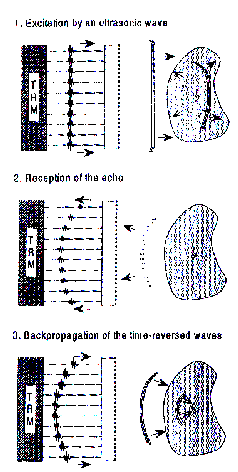Time Reversal of Ultrasonic Waves in Solids
Carsten Draeger, Didier Casereau and Mathias Fink – didier.cassereau@loa.espci.fr
Laboratoire Ondex et Acoustique
ESPCI, CNRS URA 1503, 10 rue Vanquelin
F-75005 Paris, France
011-33-1-40-79-44-69
Popular version of paper 1pPA5 presented at the 130th ASA Meeting in St. Louis, Missouri
The high security rules in industrial domains like aircraft construction or nuclear power plants require better and better detection methods to trace very small defects that can, under special circumstances, lead to a catastrophe. Among the large number of methods used at this time, one can find X-rays,…. and (more and more) ultrasonic echography. As well as the pregnant woman can have a look at its baby, technicians try to detect cracks inside a material using acoustic waves. However, dangerous cracks are generally much smaller than a baby, and their faint echo is often drowned in noise. The main trick to avoid these difficulties consists in focusing an ultrasonic beam directly on the defect; hence, we get a strong echo that can emerge from the noise. Anyway, this is particularly delicate due to the two following subsequent questions: does the crack exist in the material? and if yes, where is it? Fortunately, proceedings have been developed recently which permit to focus automatically on the position of an existing crack.
For several years, our laboratory has developed and improved an Acoustic Time-Reversal-Mirror. It is based on one of the fundamental principles of Physics in lossless propagation media; the time-reversal invariance. This means that, starting with any propagating wave, it is possible to consider another wave with exactly the same characteristics, except that is propagates in the reverse direction. This second wave behaves just as if time was counting backwards: a wave propagating from the left to the right can be changed to a similar wave that now propagates from the right to the left; similarly, a diverging spherical wave can be changed to its converging counterpart. Converging means focusing, and that is precisely what we are interested in! Furthermore, a diverging wave coming from the crack is directly available from the experiment: it results from the faint echo reflected by the crack.
This basic idea yields the following experimental procedure. In a first step, we illuminate the materials to be tested with an ultrasonic wave like in classical proceedings. If a crack is present, it generates a faint but detectable echo; this echo is received by the TRM, that consists of a 2D-array of small transducers (i.e. ultrasonic microphones and speakers at the same time) and it is stored in memories; this corresponds to the second step of the process. Finally, the third step consists in throwing back the received signals, after they have been amplified and reversed in time (last in–first out process), therefore resulting in the time reversed wavefield. Following the basic principle of time reversal, this reversed wavefield backpropagates to its initial source, thus to the location of the crack. This three-step process yields a strong signal focused on the crack that proves its existence; it is illustrated by the figure below. It is also interesting to note that we do not obtain any focusing effect if there is no crack in the material to be tested.

In this paper, we show theoretically and experimentally, that our method works even though. The two kinds of waves created in the solid are partially transmitted into the water and can be recorded by the TRM, therefore resulting in different wavefronts that can be separated in time. After time- reversal, the total wavefield backpropagates into the solid, mainly resulting, among other things, to the initial longitudinal and transverse waves. In spite of their different wave speeds, they are both focused at the same time and location! Even in such complex systems, everything happens as if time was counting downwards, except some additional harmless noise.
